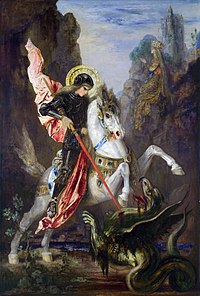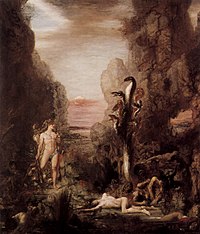Enormous

Monster or monster is an expression for creatures, usually imaginary fantasy animals ("monsters"), which stand out due to their size, strength or ugliness. Monster or monster denotes an unnatural, mostly ugly and frightening structure or a deformity. When referring to actually living persons, monster also means monster or monster .
definition
The word monster comes from the Old High German unehiuri " unheimlich " (terrible, spooky, ghostly, gruesome, monstrous) as the opposite of gehiure " heuer " (comfortable, gentle, peaceful), which is derived from hiuri "calm": to the same settlement or house community indicating the appropriate spirits or their condition.
The term "monster" is derived from the Latin monstrum "warning sign", as well as monstrare "show" and monere , "admonish, warn". In the narrower sense, what is usually meant is a being that is unformed in relation to a person who is seen more ideally. Its malformation finds its sole purpose initially in reference to the measure - an ideal in both physical and ideal terms. Above all in the context of the theological thinking of the Church Fathers and the Middle Ages , the monster is a warning sign that is intended to point out the dangers and consequences of deviating from the correct faith, which is thus consciously set by God. In his etymologies (11, 3), Isidore of Seville accordingly derived the name from the Latin monitum , "hint, prophecy". Monsters in this area of the picture could be animals, mythological hybrid beings , but also “human beings” ( Augustine von Hippo : monstra sunt in genere humano “monsters are part of the human race”), which were described as miraculous peoples . The expression monster finds its way into the general Usage through literature, first used in 1818 by Mary Shelley in Frankenstein or the modern day Prometheus .
backgrounds
The term monster is mostly used today to refer to a fantastic creature with strong frightening components, but also colloquially to everyday things that meet the criteria mentioned above.
Monsters as fictional creatures usually have their origin in the imagination of people or in nightmares and symbolize fears that can be more easily processed in personified myths or fairy tales . In mythology , malformed people (e.g. cyclops ) and hybrid beings are referred to as monsters . They sometimes have animal bodies and animal heads (e.g. the griffin or dragon ), animal bodies and human heads (e.g. the sphinx with a woman's head and lioness's body, or centaurs with a human torso and horse's body). There are also depictions of animal-headed ( theriocephalic ) demons and even gods (especially in Egypt) with at least human-shaped legs.
Also from the Cryptozoology sightings reported by "real" existing monsters regularly. A prominent example is the Loch Ness Monster . In addition to such fantastic and extremely improbable beings, there are and have been sightings of monsters that have turned out to be real (such as the Komodo dragon , the mountain gorilla , the giant squid or the giant mouth shark ), or at least could exist with a relatively high probability.
They have the function of nightmares or monsters and show children the horror as well as possible answers to them ( child horror figure ).
Based on this, brutal, immoral people were also referred to as monsters in the past; monsters were also freak births or people with deformities. Nowadays these terms are rarely found in everyday language .
The Sesame Street introduced a new, lovable monster type, whose most representative tester probably the Cookie Monster is. Elliot, the smirking monster or the main actors in the animated film Die Monster AG are similarly humorous .
Dietlind Neven-du-Mont created another lovable monster in her book Das Getüm (1970).
A special exhibition at the Germanisches Nationalmuseum Nürnberg from May to September 2015 was devoted to monster myths from the Middle Ages to the present day by means of representations in books, paintings, sculptures, cinema posters and film clips.
Famous monsters
Commonly known monsters or monsters
- Antipodes
- basilisk
- Blemmyae
- Boogeyman
- Cthulhu
- Dragons
- Digimon - Digi tale Mon ster (a creation of the toy manufacturer Bandai )
- unicorn
- Elliot, the smiley monster
- Flying spaghetti monster
- Frankenstein's monster
- Godzilla (see Toho Studios; kaiju )
- Gorgons
- Mummies
- Hydra - a nine-headed sea monster from Greek mythology
- Gremlin
- Grendel
- Hulk
- Jabberwocky
- King Kong - oversized gorilla, who has been processed as a film character since the beginning of the 20th century
- Goblins / Bilwis
- Cookie Monster in the children's series Sesame Street
- Lindwurm - dragon of Germanic mythology
- Pokémon - Poke tto Mon sutā (Pocket Monster; a creation of the video game manufacturer Game Freak )
- Roch - an oversized bird, which, among other things in the tales of the Arabian Nights was processed
- Scylla and Charybdis
- Sphinx , a lion with a human head (originated in ancient Egypt)
- Tarasque - dragon that was up to mischief in the southern French village of Nerluc (today Tarascon )
- Werewolf - half human and half wolf
- Zombie - walking dead
Fictional works
- Bellerophon myth
- Beowulf
- Call of Cthulhu
- Beauty and the Beast , traditional folk tale from France (approx. 18th century), which was filmed several times and staged as a musical
- Dracula
- Frankenstein
- Dragon slayer legend of St. George
- The twelve labors of Heracles ("Dodekathlos") for Eurystheus
- The Hobbit
- Harry Potter (novel and film series)
- Lord of the Rings
- Jabberwocky , in Through the Looking Glass
- Jack and the Beanstalk
- Saint Martha and the Tarasque (legend)
- Characters in the film Die Monster AG
- The Odyssey
- Myth of Perseus
- Theseus and Minotaur
- Alien (film series)
mathematics
- The monster group is the most powerful sporadic simple group .
- The baby monster is a slightly smaller but still very formidable sporadic simple group .
See also
literature
- Kurt Röttgers and Monika Schmitz-Emans : Monster. Series Philosophical-literary Reflections, Vol. 12, Verlag Die Blaue Eule, Essen 2010, ISBN 978-3-89924-301-7 .
- Wolfgang Schwerdt : Different times, different dragons. A cultural history of the dragon. Past Publishing, Berlin 2010, ISBN 978-3-940621-25-2 . - About dragons and monsters in the Near Eastern-Western cultural history from antiquity to today.
- Michael Hagner (ed.): The wrong body. Contributions to a history of monstrosities , undated, Göttingen 1995.
- Lorraine Daston, Katherine Park: Wonders and the Order of Nature 1150-1750 , n.v., New York 1998.
- Hans Richard Brittnacher: Aesthetics of Horror. Ghosts, vampires, monsters, devils and artificial people in fantastic literature , n.v., Frankfurt a. M. 1994.
- Ulrich Müller, Werner Wunderlich (ed.): Demons, monsters, mythical creatures , (= medieval myths, volume 2), UVK specialist publisher for science and studies, Konstanz 1998, ISBN 978-3-86764-118-0 .
- Marco Heiles: Monsters and Humanists. On the change in meaning of the monster in the late Middle Ages , 2010, online at hcommons.org [ accessed on April 6, 2017].
- Ulisse Aldrovandi , Monstrorum historia cum Paralipomenis historiae omnium animalium , Bononiae, Nicolò Tebaldini, 1642 - Digital version
- Christian Hünemörder : The strange human races of the Orient - fiction and - alleged - reality. In: Dominik Groß and Monika Reininger (eds.): Medicine in history, philology and ethnology: Festschrift for Gundolf Keil. Königshausen & Neumann, Würzburg 2003, pp. 370–377.
- Urte Helduser: Imaginations of the monstrous. Knowledge, literature and poetics of the “freak” (1600–1835). Wallstein, Göttingen 2016.
Web links
- Definition according to DWDS
- Monstrula.de - website about monster films
- Johann Christoph Adelung : Grammatical-Critical Dictionary of High German Dialect , Volume 4, o. V., Leipzig 1801, p. 856 (the monster)
- Almut Höfert (ed.): Miracles and monsters in the Middle Ages. Living History Books (digital anthology with open access sources, 2015) [1]
Individual evidence
- ↑ Markus Dederich : Body, Culture and Disability. An Introduction to Disability Studies. Transcript, Bielefeld 2007, ISBN 978-3-89942-641-0 , p. 89 ( page preview in the Google book search).
- ^ Friedrich Kluge , Alfred Götze : Etymological dictionary of the German language . 20th edition. Edited by Walther Mitzka . De Gruyter, Berlin / New York 1967 (reprint “21st unchanged edition”, ibid. 1975, ISBN 3-11-005709-3 , p. 804: heir ).
- ^ Hünemörder, 2003: pp. 373–374.
- ↑ Gabriele Thome : Concepts of evil in Latin literature: terms, motifs, shapes. Steiner, Stuttgart 1993, ISBN 3-515-06312-9 , also habilitation thesis, University of Munich 1990, p. 100 ; Rasmus Overthun: The Monstrous and the Normal. Constellations of an aesthetic of the monstrous. In: Achim Geisenhanslüke , Georg Mein (Hrsg.): Monstrous orders. On the typology and aesthetics of the abnormal. Transcript, Bielefeld 2009, ISBN 978-3-8376-1257-8 , pp. 43-79, here p. 46.
- ↑ Urs Zürcher : Monster or Mood of Nature. Medicine and the study of malformations 1780–1914. Campus, Frankfurt am Main 2004, ISBN 3-593-37631-8 , p. 11.
- ↑ Monster exhibition in Nuremberg, Scary and beautiful horror , Deutschlandradio Kultur from May 4, 2015
- ↑ Information from the Germanisches Nationalmuseum on the special exhibition ( Memento from July 2, 2015 in the Internet Archive )

